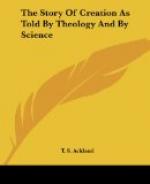The earliest sedimentary rock with which we are acquainted at present is what is known as the Laurentian formation. [Footnote: The whole of the geological details in this section are taken from Sir C. Lyell’s Geology for Students.] It occupies an area of 200,000 square miles north of the St. Lawrence; and is also traced into the United States and the western highlands of Scotland and some of the adjacent isles. It is divided into two sections—the Upper and Lower Laurentian. It is not certain that it is really the oldest rock; for as every sedimentary rock is formed of the debris of preceding rocks, it is very possible that all the exposed portions of some older rocks may have been decomposed and worn away; but it is the oldest yet known. The thickness of the lower portion is estimated at 20,000 feet, or nearly four miles, while the Upper Laurentian beds are 10,000 feet thick. At this point we meet with the first traces of that process of upheaval and subsidence which has ever since been going on in the earth. The Lower Laurentian rocks had been displaced from their original horizontal position before the Upper Laurentian were deposited upon them.
This process of upheaval of some parts of the earth, accompanied with subsidence in other parts, is one which cannot be accounted for by any natural laws with which we are acquainted. It is in all probability the result of a series of changes which are taking place in the interior of the earth, but of which we know nothing at all. It is in the commencement of this series of changes that we trace that direct interference of the Creator—which is indicated by the command, “Let the waters under the firmament be gathered together into one place, and let the dry land appear.” We have not, however, any means of ascertaining how long a period elapsed before the process of upheaval reached the point at which the land would rise above the surface of the ocean.
The Lower Laurentian rocks are remarkable in another way. There is little doubt that traces of life, the earliest yet known, occur in them. They include a bed of limestone varying in thickness from 700 to 1500 feet. In all probability limestone, wherever it occurs, is an animal product, though in many cases all traces of its organization have been lost by exposure to heat. This particular bed appears to have been formed by a very lowly creature, which in organization was akin to the foraminifera, of which large quantities are now known to exist at the bottom of the Atlantic. It differed from them, however, in one respect—the individuals were connected together, as is the case now with many varieties of the coral animal. No notice of this first appearance of life is found in the Mosaic Record, nor, for reasons already given, was it possible that any mention of it should be made.




